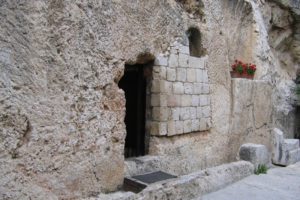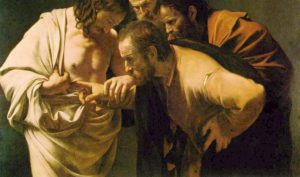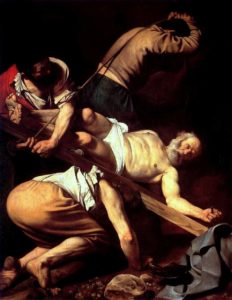by Graham Phillips | The resurrection of Jesus of Nazareth is the cornerstone of the Christian faith and arguably the most controversial event in human history. Jesus is said to have risen from the dead on the third day after his crucifixion at the hands of Pontius Pilate. In this resurrected state he was then witnessed by over 500 of his followers on at least eight separate occasions over a period of around 40 days. If the gospel accounts of the resurrection are true then Jesus really is God and we ought to worship Him, if not then Christianity is a sham and we must expose it. High stakes.
So, what can we know about the resurrection? Is blind faith our only route to ‘knowing’ anything of it? Or can belief in the ressurection be reasonable? There are several lines of evidence surrounding the reported resurrection of Jesus that demand an explanation. As with anything in ancient history it is nigh on impossible to prove something 100%, instead what we hope to do is to arrive at a conclusion which best explains the available evidence. Proof beyond a reasonable doubt is what we are looking for. The three lines of evidence that we will consider are historical facts agreed upon by the large majority of scholars; 1) That the tomb was found empty 2) Post mortem appearances 3) The origin of the Christian faith.
1. The Empty Tomb
That Jesus was buried in the tomb belonging to Joseph of Arimathea,

The supposed tomb belonging to Joseph of Arimathea
a prominent member of the council, is one of the best attested facts about Jesus. Mentioned specifically in each of the four gospels, we can be confident that Joseph of Arimathea’s tomb was where Jesus’s body was laid immediately after it was taken down from the cross. The gospel accounts are the earliest and are treated as the most reliable sources for the person of Jesus of Nazareth; to find out why read this post.
“And when evening had come, since it was the day of Preparation, that is, the day before the Sabbath, Joseph of Arimathea, a respected member of the council, who was also himself looking for the kingdom of God, took courage and went to Pilate and asked for the body of Jesus. Pilate was surprised to hear that he should have already died. And summoning the centurion, he asked him whether he was already dead. And when he learned from the centurion that he was dead, he granted the corpse to Joseph. And Joseph bought a linen shroud, and taking him down, wrapped him in the linen shroud and laid him in a tomb that had been cut out of the rock. And he rolled a stone against the entrance of the tomb. Mary Magdalene and Mary the mother of Joses saw where he was laid.”
Mark 15:42-47
Why is this information important you might ask? Well, as a man of high standing, the location of Joseph’s tomb would have been known to both Jew and Roman. Meaning that if news went around that Jesus had risen from the dead the authorities or skeptics could have falsified those claims by visiting the tomb and presenting the corpse. Moreover, Joseph of Arimathea was a member of the Jewish council that had condemned Jesus to death, seemingly one of the last people who you would expect to give up his tomb for him. Therefore it would appear implausible that the writers of the gospels and earlier source texts would have made this up. Each of the four gospels attest the empty tomb however the narrative isn’t identical in each account and there are extra details presented in the gospels of Matthew, Luke and John not found in Mark suggesting they were working with other independent sources asides from Mark’s Gospel.
Furthermore, in each of the Gospel accounts the empty tomb is discovered by women. Near eastern culture in the 1st century was extremely patriarchal, in fact the testimony of women in a court of law was counted as naught according to contemporary historian, Josephus.
“Let not the testimony of women be admitted, on account of the levity and boldness of their sex” – Josephus, Antiquities IV.8.15
If the writers of the gospels simply made it all up, this particular detail would never have made the cut. They would surely have substituted the women for Peter and John in an attempt to convince a few more to believe their story. The inclusion of this detail of the women being the first to discover the empty tomb in each of the four gospel accounts means that it’s highly probable that they really did. The fact of the empty tomb is further verified by the response of the Jewish authorities to the Jews of the resurrection found in Matthew 28:11-15 that the disciples stole his body away. Both the Jewish and Roman authorities were interested in quelling the spread of Christianity, all they needed to do to was produce Jesus’s body, clearly they were unable to do so. The tomb of Joseph of Arimathea which contained the body of Jesus on the evening of the day of preparation no longer did on the following Sunday morning.
“By far most scholars hold firmly to the reliability of the biblical statements about the empty tomb.” – Jacob Kramer, New Testament Critic
2. Post-mortem Appearances
“It may be taken as historically certain that Peter and the disciples had experiences after Jesus’s death in which Jesus appeared to them as the risen Christ.” – Gerd Ludemann, New Testament Scholar & Atheist
There are twelve resurrection appearances mentioned in the New Testament and they are as follows:
- Mary Magdalene – Sees, hears and touches Jesus (Mark 16:9-19; John 20:11-18)
- The other women – See, hear and touch Jesus (Matt 28:9-10)
- Peter – Sees and hears Jesus (Luke 24:34; 1 Cor 5:5)
- Two disciples – See, hear and eat with Jesus (Luke 24:13-31; Mark 16:12)
- Ten disciples – See and bear Jesus, are invited to touch him and witness him eat (Mark 16:14-20; Luke 24:35-52; John 20:19-24; Acts 1:3-9; 1 Cor 15:5)
- Eleven disciples – See and hear Jesus and are invited to touch his scars (John 20:26-29)
- Seven disciples by the Sea of Galilee – See, hear and eat with Jesus (John 21:1-23)
- Five hundred disciples in Galilee – See and hear Jesus (1 Cor 15:6)
- Eleven disciples in Galilee – See and hear Jesus (Matt 28:18-20)
- James (Jesus’s brother) – Sees and hears* Jesus (1 Cor 15:7)
- All the apostles in Jerusalem – See, hear and eat with Jesus (1 Cor 15:7; Mark 16:15-20; Luke 24:46-52; Acts 1:3-9)
- Paul – Sees and hears Jesus (Acts 9:1-8; 1 Cor 9:1; 15:8

Thomas inspects Jesus’s wounds
These appearances were certainly very real to those who witnessed them, the were transformed by them; from fugitives hiding from the authorities to boldly preaching the resurrected Christ. The resurrection accounts were central to the early Christian church. Scholars believe that in 1 Corinthians 15:3-8 we find arguably one of the earliest creeds:
“For I delivered to you as of first importance what I also received: that Christ died for our sins in accordance with the Scriptures, that he was buried, that he was raised on the third day in accordance with the Scriptures, and that he appeared to Cephas, then to the twelve. Then he appeared to more than five hundred brothers at one time, most of whom are still alive, though some have fallen asleep. Then he appeared to James, then to all the apostles. Last of all, as to one untimely born, he appeared also to me.”
1 Corinthians 15:3-8 ESV
Paul’s epistles are among the earliest of New Testament writings and scholars believe this creed was likely picked up by Paul during his time in Jerusalem with Peter and the other apostles and likely dates to just a few years after Jesus’s death in AD 33. The short creed contains no less than six resurrection appearances including Paul’s own encounter, Peter’s (Cephas), an appearance to 500 men at once and also James’s. Jesus’s half brother, James was a skeptic. We know that he didn’t believe that Jesus was who he claimed to be while he was ministering (John 7:5), however he went on to lead the church at Jerusalem until his martyrdom in around 60AD. The catalyst for this radical change in belief? A meeting with the resurrected Jesus. Paul too was an enemy of the early church, a devout Jew and a well educated man he had Christians beaten and imprisoned under the authority of the Sanhedrin. His remarkable transformation is owed to his encounter with the risen Jesus on the Damascus road (Acts 9:3-9). The creed is an appeal to eye witnesses of the risen Christ. Remarkably, it states that Jesus appeared to more than 500 brethren at once and that most of these are still alive today. Why include this detail? It is saying; check it out with them if you don’t believe me! Whatever we might conclude about the nature of these appearances the conclusion that a significant number of people had powerful encounters with a person whom they believed to be the risen Jesus is virtually undeniable.
3. The Rise of Christianity
How the Apostles died
Peter – Crucified upside down in Rome around 66AD. He did not consider himself worthy to die in the same manner as Jesus.
Paul – Beheaded in Rome around 66AD.
Andrew – Crucified in Greece.
Thomas – Pierced through with spears.
Philip – Put to death by a Roman proconsul in Asia Minor after the proconsul’s wife converted to Christianity.
Matthew – Some of the oldest reports say he was not martyred, others however say he was stabbed to death in Ethiopia.
Bartholomew – Martyred for preaching the Gospel on one of his ministry trips.
James (the son of Alpheus) – Stoned and then clubbed to death.
Simon the Zealot – Martyred in Persia after refusing to sacrifice to the sun god.
Matthias – Burnt to death while ministering in Syria.
John – The only one thought to have died of natural causes in old age.
How convinced of a fact would you have to be to suffer torture and death for it? What is clear is that the apostles were convinced beyond a shadow of a doubt that Jesus had risen from the dead. This event

Peter is crucified
transformed them from fearful fugitives (John 20:19), hiding from the authorities to avoid meeting the same fate as their leader into men willing to be brutally murdered rather than renege on their conviction. We must also remember that these men were Jewish, the idea that the Messiah would be shamefully executed by enemies of Israel was literally unconscionable for the Jew. The disciple’s faith in Jesus as the Messiah would have been shattered by the crucifixion, it is hard to overstate this fact. They simply would not have been expecting Jesus to rise from the dead, so to make the claim that he had as a Jew would have made absolutely no sense, unless they had very good reason to make the claim.
Christianity spread like wildfire through the Roman Empire in the 1st and 2nd centuries, despite the fact that converting to Christianity came with a heavy price tag, persecution and even death in many cases. It is said that the emperor Nero would light his garden with the burning bodies of Christians! The belief in the resurrection of Jesus was absolutely central to the rise of early Christianity. Without this catalyst it is extraordinarily difficult to account for the rapid spread of a faith which brought it’s adherents almost certain persecution.
Historical Method
In order to determine the best explanation for these lines of evidence we must adopt a methodology. Historians will weigh each hypothesis by subjecting them to the following criteria:
- Explanatory scope – The best explanation will explain more of the evidence than competing hypotheses
- Explanatory power – The best explanation will make the evidence seem more probable
- Plausibility – The best explanation will be the most plausible.
- Least contrived – The best explanation won’t require us to adopt as many new beliefs that have no independent evidence.
- Disconfirmed by the fewest accepted beliefs – The best explanation won’t conflict with as many accepted beliefs.
- The best explanation will meet conditions I-V much better than competing hypotheses.
That Jesus actually did rise from the dead is the best explanation for the evidence shown here. It meets conditions 1-5 far better than other competing theories. The Resurrection hypothesis explains each of the three lines of evidence; the empty tomb, the post-mortem appearances and the rise of Christianity meaning it has extremely good explanatory scope. Perhaps the strongest part of this hypothesis is its explanatory power, it makes sense of the empty tomb, the resurrection appearances and in particular the radical transformation of the disciples. The hypothesis may seem implausible or require us to adopt new unsupported beliefs at first glance. However, we must take into account what is known of the man in question; that it is extremely well documented that he worked miracles (even critics and skeptics at the time acknowledged this), that he claimed to be the son of God and that he predicted his own resurrection. This was no ordinary chap. A hypothesis invoking the supernatural would be perfectly logical in this unique case.
The only rival hypothesis that is seriously defended by scholars in relevant fields is the ‘Hallucination Hypothesis’. This theory proposes that the post-mortem appearances of Jesus were merely hallucinations experienced by Jesus’s followers. There are several obvious flaws with this theory. Firstly, it has no answer to the empty tomb. If the appearances were just hallucinations then there should have still been a body in the tomb. We would then need to posit a reason without any supporting evidence for the empty tomb or simply deny the existing evidence. Secondly, hallucinations are like dreams, the exact same hallucination cannot be seen by many people all at once. Jesus’s post-mortem appearances were witnessed by groups of people and even by supposedly 500 men at once. The hallucination theory does a bad job of explaining this manner of appearance. Finally, I know the difference between a dream and something I am really witnessing at a moment in time. It doesn’t seem likely to me that all but one of the early apostles would have given up their lives as readily as they did for what is essentially a vivid dream, no matter how potent. Equally, why would Paul, an enemy of Christianity have one of these hallucinations? Moreover, can we really imagine that a hallucination of any kind would have been powerful enough to have wrought such a radical about-turn in the man’s life? For me, it is a stretch too far.
There are several other theories worthy of a mention including the Conspiracy Hypothesis, Apparent Death Hypothesis and Displaced Body Hypothesis. None of these are currently defended by scholars although they still appear capable of garnering a good few column inches here and there.
Conspiracy Hypothesis; that the disciples stole the body and fabricated the post-mortem appearances has decent explanatory scope. However, as scholar Craig Blomberg has said, ‘liars make terrible martyrs’, the disciples surely wouldn’t endure torture and death for something that they knew was false. Apparent Death Hypothesis postulates that Jesus wasn’t fully dead after crucifixion but revived in the tomb and escaped to the disciples. Firstly, the notion that Jesus would have survived the particular crucifixion he endured is implausible. Secondly, what kind of a state would he have been in had he survived? A good enough state to convince the disciples he had resurrected? He would have needed round the clock medical attention, hardly the kind of visage to inspire belief in a risen messiah! Displaced Body Hypothesis explains the empty tomb, saying that Joseph of Arimathea moved it to the criminals graveyard on the sabbath. However, there is no independent evidence of this actually taking place. Crucially it does nothing to explain the appearances or the origin of the disciples belief in the resurrection.
Suffice to say, belief in the resurrection of Jesus Christ is reasonable indeed. It is the best explanation of the available evidence (of which there is a great deal). Once one is willing to entertain that in the case of a man who is known to have worked miracles, who claimed to be the son of God and predicted his own resurrection a supernatural explanation might just be possible, the Resurrection Hypotheses is hard to deny.
Sources
On Guard – William Lane Craig
When Skeptics Ask – Norman Geisler
The Case for Christ – Lee Strobel
Whatever Happened to the 12 Apostles – Ken Curtis Ph.D.


Leave a Reply